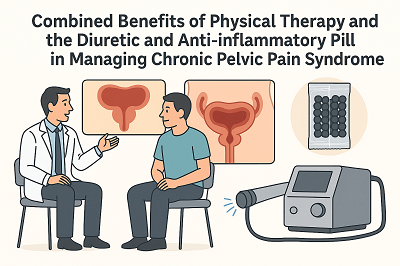Combined Benefits of Diuretic and Anti-inflammatory Pill with Physical Therapy for Chronic Pelvic Pain Syndrome(CPPS)
Chronic Pelvic Pain Syndrome (CPPS) is one of the most challenging conditions in urology and andrology. Men suffering from CPPS often experience persistent discomfort in the lower abdomen, perineum, and lower back. This condition also interferes with urination and sexual function. Traditionally, treatments focused on antibiotics and alpha-blockers, but their effects have been quite limited.

In recent years, physical therapy has gained attention, along with the Diuretic and Anti-inflammatory Pill, a Traditional Chinese Medicine (TCM) formula known for its unique pharmacological actions. Together, these two treatment options have opened a promising new path for CPPS patients.
Understanding the Pathological Mechanisms Behind CPPS
CPPS has a complex pathology involving dysfunctions in the nervous, immune, and endocrine systems. Key contributors to chronic pain include fibrosis of the prostate stroma, smooth muscle spasms, and sensitization of nerve endings. Persistent inflammation triggers the abnormal release of neuropeptides like Substance P and calcitonin gene-related peptide (CGRP), heightening peripheral nerve sensitivity.
The central nervous system may further amplify pain signals, intensifying symptoms. Additionally, pelvic floor muscle spasms, such as those in the levator ani or piriformis, can create a vicious cycle of "pain-spasm-pain," worsening pelvic congestion and discomfort.
Limitations of Conventional Treatments
Standard therapies come with notable drawbacks:
Antibiotics: Only effective in bacterial prostatitis and often lead to antibiotic resistance in CPPS cases.
Alpha-blockers: Help with urination issues but offer limited pain relief.
NSAIDs: Provide short-term pain relief but pose long-term risks like gastrointestinal bleeding.
Conventional treatments also fail to restore pelvic floor function, regulate nerve activity, or improve immune modulation—leaving many symptoms unresolved.
The Role of Physical Therapy in CPPS Management
Physical therapy offers a non-drug approach to improving local blood flow, relieving muscle spasms, and restoring nerve function. Common methods include:
1. Shockwave Therapy
This technique uses high-energy acoustic pulses to stimulate circulation, enhance nutrient delivery, promote collagen production, and accelerate tissue repair. Shockwave therapy also modulates nerve endings to reduce pain signal transmission, providing direct relief to pelvic tissues.
2. Electrical Stimulation
By applying targeted electrical currents to the pelvic floor muscles and nerves, this method alleviates muscle tension and spasms. It improves blood flow and metabolism while regulating nerve excitability—resulting in pain reduction and better muscle control.
3. Heat Therapy
Thermal treatments dilate blood vessels, expel inflammatory factors, and relieve muscular tension. As a safe and simple adjunct therapy, heat helps reduce pain, support tissue regeneration, and amplify the effects of other treatments.
4. Biofeedback and Pelvic Floor Muscle Training
Biofeedback helps patients understand and control pelvic muscle function using real-time feedback on muscle activity. When combined with regular pelvic floor exercises, it corrects dysfunction, improves muscle tone, and prevents complications like organ prolapse.
5. Deep Tissue Massage
This hands-on technique targets deep pelvic tissues to enhance circulation, ease muscle spasms, and stimulate nerve repair. It also accelerates the absorption of inflammation and supports overall symptom improvement.
Pharmacological Actions of the Diuretic and Anti-inflammatory Pill
Diuretic and Anti-inflammatory Pill draws on Traditional Chinese Medicine principles and offers a multi-targeted approach to CPPS. Key ingredients like Plantago Seed, Polygonum, Dianthus, and Talcum promote diuresis and clear urinary tract inflammation by increasing urine flow and flushing out pathogens and inflammatory waste. Additional herbal components detoxify the system, fight infection, and relieve pelvic congestion.
The formula also promotes blood circulation and resolves stasis, helping reduce pelvic edema and pain. Importantly, the Diuretic and Anti-inflammatory Pill enhances the body’s immune function and tissue repair, addressing the root causes of CPPS holistically.
Synergistic Effects: Why Combining Physical Therapy with Herbal Treatment Works
1. Complementary Mechanisms
Physical therapy works on the physiological level—improving blood circulation, relaxing muscles, and restoring nerve health. The Diuretic and Anti-inflammatory Pill, meanwhile, works from the inside out—balancing Qi and blood, promoting detoxification, and resolving inflammation and blood stasis.
2. Additive Relief of Symptoms
This combination results in greater symptom relief. For example, heat therapy alleviates pain sensitivity, while pelvic floor training restores muscle function. Meanwhile, the herbal pill enhances urination and circulation, reducing pelvic inflammation and discomfort.
3. Holistic Physical and Mental Support
CPPS affects not only physical health but also emotional health, often leading to anxiety and depression. Physical therapies relax the body and provide comfort, while the Diuretic and Anti-inflammatory Pill improves the internal environment, promotes self-healing, and helps patients regain confidence in their recovery.
Conclusion
The integration of physical therapy with the Diuretic and Anti-inflammatory Pill represents a highly effective treatment strategy for CPPS. By combining modern rehabilitative techniques with time-tested herbal medicine, this East-meets-West approach addresses both the symptoms and root causes of chronic pelvic pain. For those struggling with CPPS, this synergy offers new hope and a tangible path to recovery.



